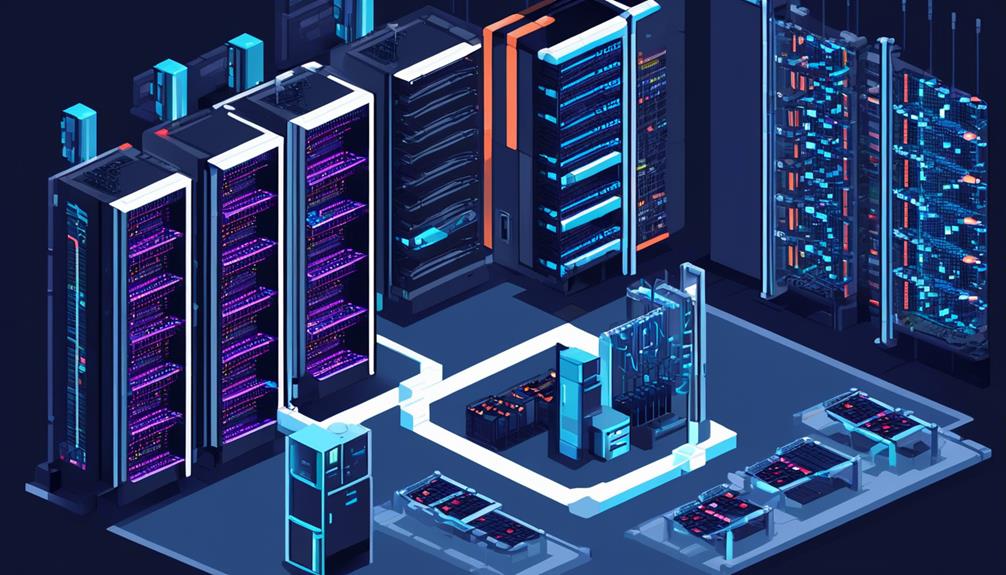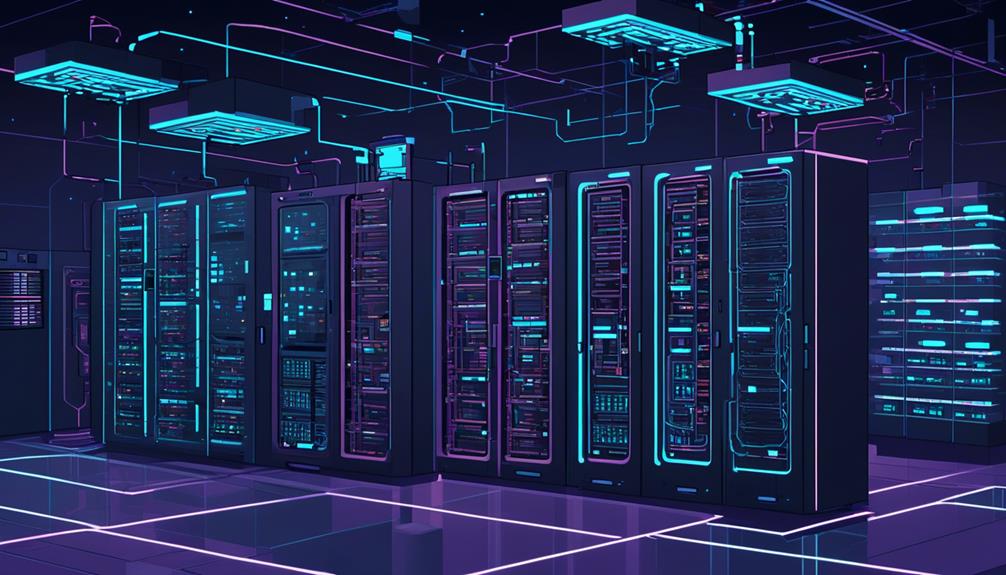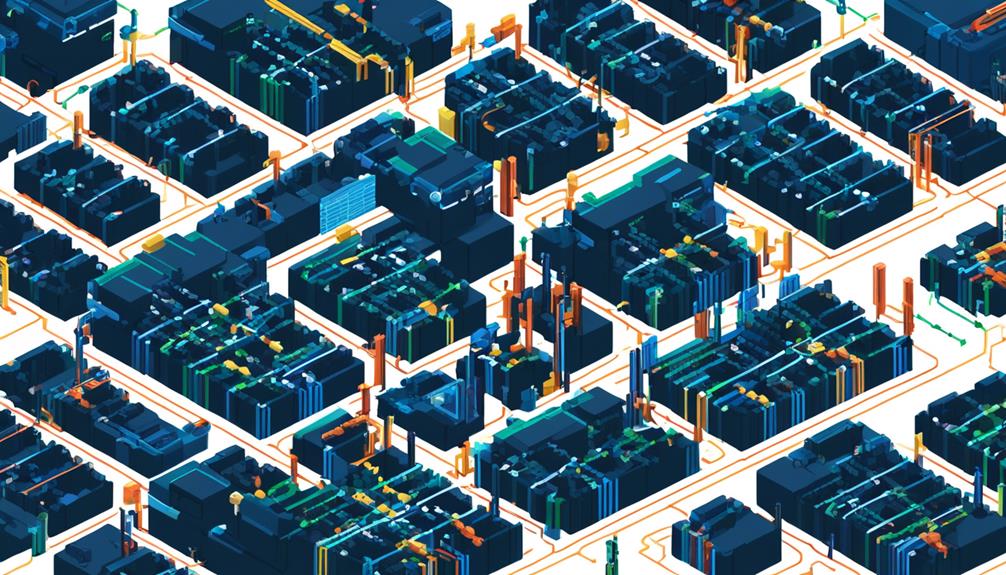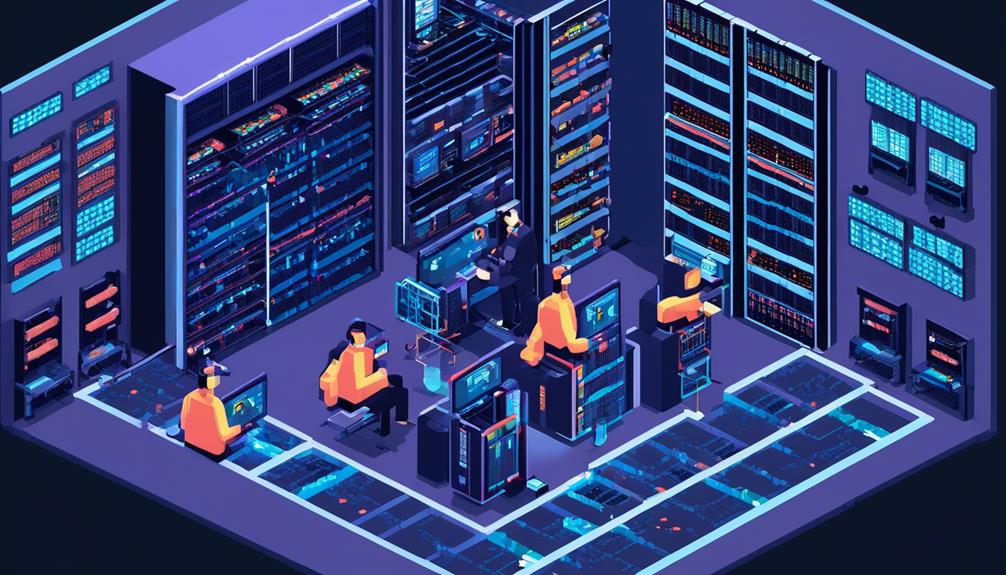Data centers play a critical role in today's digital landscape, serving as the backbone of countless online services and applications. As the demand for faster and more reliable connectivity continues to grow, data center operators are turning to artificial intelligence (AI) to enhance their connectivity capabilities.
By leveraging AI, data center connectivity can be optimized in real time, allowing for more efficient resource allocation, reduced energy consumption, and improved overall performance.
In this discussion, we will explore the various ways in which AI is enhancing data center connectivity, from AI-optimized hardware to AI-driven network management solutions.
Get ready to discover how AI is revolutionizing data center connectivity and paving the way for a more connected future.
Key Takeaways
- AI-optimized hardware and network management enhancement allow data centers to allocate resources more effectively for AI applications.
- AI-driven network optimization streamlines network operations, improves efficiency, and reduces energy consumption.
- Intelligent network troubleshooting proactively identifies and resolves network issues, enhancing reliability and efficiency.
- Scalability of AI-driven connectivity solutions and predictive maintenance enable data centers to accurately plan for future connectivity needs, reduce downtime, and optimize critical infrastructure components.
AI-Optimized Hardware

AI-optimized hardware, including specialized components such as GPUs (Graphics Processing Units) and TPUs (Tensor Processing Units), is essential for meeting the high processing power demands of AI applications in data centers. These hardware components are specifically designed to support the computational requirements of AI algorithms, enabling data centers to optimize performance and handle the increased workload associated with AI-enabled applications.
AI-optimized hardware plays a crucial role in enhancing the performance, scalability, and efficiency of AI applications in data centers. GPUs, for example, excel at parallel processing and are highly effective in accelerating AI training tasks. They are capable of handling large amounts of data simultaneously and performing complex mathematical calculations, which is essential for training deep learning models.
TPUs, on the other hand, are specifically designed for executing AI models with high efficiency. They offer significant improvements in performance per watt compared to traditional CPU-based systems, making them ideal for inference tasks where low latency and power consumption are critical.
By incorporating AI-optimized hardware, data centers can allocate resources more effectively and efficiently. This hardware enables data centers to handle the higher power density and heat management requirements of AI, ensuring optimal performance and reliability.
Furthermore, AI-optimized hardware is essential for future-proofing data center infrastructure in the era of AI. As AI applications continue to evolve and become more complex, the demand for processing power will only increase. Data centers that embrace AI-optimized hardware will be better equipped to handle these demands and stay competitive in the market.
Network Management Enhancement
Network management enhancement through AI-driven optimization is crucial for efficient and reliable data center connectivity. AI algorithms can analyze and optimize network traffic, dynamically adjusting routing paths and bandwidth allocation to ensure optimal performance and minimize latency.
Streamlining network operations is another key aspect of network management enhancement. By leveraging AI, network administrators can automate network configuration and provisioning, proactively identify and resolve network issues, and enhance overall network efficiency.
Intelligent network troubleshooting is also an essential component of network management enhancement. AI can help in identifying and resolving network issues by analyzing network data and providing actionable insights. This can lead to improved productivity and reduced downtime in data center environments.
Ai-Driven Network Optimization
With the integration of artificial intelligence, data center connectivity is enhanced through advanced network optimization techniques. AI-driven network optimization allows for real-time dynamic management of data center environments, improving operational efficiency for data center operators. By leveraging artificial intelligence and machine learning, data center operators can achieve intuitive and efficient management of cooling units. AI enables the matching of cooling units to the load they are serving, reducing the speed of lightly loaded units and increasing the effort of heavily loaded units for optimal efficiency. Additionally, AI enables constant monitoring and quick notification of cooling issues, ensuring proactive management and minimizing downtime. Machine learning further enhances the effectiveness and efficiency of AI-driven network optimization over time, as the system learns from data patterns and optimizes network performance accordingly.
| Benefits of AI-driven Network Optimization |
|---|
| Real-time dynamic management of data center environments |
| Intuitive and efficient management of cooling units |
| Constant monitoring and quick notification of cooling issues |
Streamlining Network Operations
To enhance network operations and improve efficiency, data center connectivity can be streamlined through advanced network management enhancement techniques. AI and machine learning play a crucial role in optimizing data centers' computing resources and improving overall performance. Here are three key ways AI streamlines network operations in data centers:
- Optimizing Cooling Systems: AI enables intuitive management of cooling units, matching their load to ensure optimal performance and cost efficiency. This dynamic optimization leads to improved operational efficiency and reduced energy consumption.
- Real-Time Environment Optimization: AI can dynamically optimize data center environments in real time, balancing the cooling units to obtain optimal efficiency. By reducing speed in lightly loaded units and increasing effort in heavily loaded units, network operations can be optimized.
- Predictive Maintenance: AI solutions enable the tracking of real power draw of individual data processing units, enhancing resource management. This allows for predictive maintenance, preventing potential failures and ensuring uninterrupted network operations.
Intelligent Network Troubleshooting
Continuing our exploration of data center connectivity, we now turn our attention to the realm of intelligent network troubleshooting, a critical aspect of network management enhancement that harnesses the power of AI to proactively identify and resolve network issues.
By leveraging AI and machine learning algorithms, intelligent network troubleshooting enables data center operators to optimize network traffic, detect and resolve congestion, latency, and connectivity problems in real-time. This AI-driven approach empowers operators to predict and prevent potential network failures by analyzing historical data and identifying patterns that may lead to issues.
Additionally, intelligent network troubleshooting allows for dynamic adjustment of network resources based on demand and usage patterns, ensuring optimal performance and responsiveness. With the integration of AI into network management, data centers can enhance their efficiency and reliability by intelligently addressing network issues before they impact operations.
Improved Connectivity Solutions
Improved connectivity solutions in data centers driven by AI provide enhanced performance, cost optimization, and operational efficiency. By leveraging AI applications, data center operators can optimize the connectivity between various components within the data center infrastructure, resulting in improved overall efficiency and reliability.
Key benefits of improved connectivity solutions in data centers include:
- Real-time monitoring and management: AI-driven connectivity solutions enable constant monitoring of data center components such as servers, switches, and storage devices. Sensors and monitoring systems can collect real-time data on performance metrics, allowing for proactive identification of connectivity issues and quick resolution.
- Enhanced network scalability: AI-driven connectivity solutions support the rigorous network scalability required for AI and machine learning workloads. These solutions can dynamically adjust network resources to accommodate the increasing demands of data-intensive applications, ensuring optimal performance and low latency.
- Predictive maintenance and future planning: With AI-based connectivity solutions, data center operators can accurately predict and plan for future connectivity needs. By analyzing historical data and utilizing predictive algorithms, operators can identify potential bottlenecks or capacity constraints in advance, allowing for timely upgrades and maintenance.
Improved connectivity solutions in data centers driven by AI not only optimize network performance but also contribute to cost savings. By intelligently managing cooling units and matching their load, AI can reduce cooling costs and enhance overall energy efficiency. This results in significant cost optimization for data center operators.
AI-Driven Data Center Infrastructure

AI-driven data center infrastructure offers a range of benefits. These include intelligent network optimization, enhanced data transfer speeds, and predictive maintenance solutions.
Through AI, data centers can optimize network configurations in real time. This ensures efficient and reliable connectivity. AI algorithms can also analyze data traffic patterns to identify bottlenecks and optimize data transfer speeds. This improves overall performance.
Additionally, AI-powered predictive maintenance solutions enable proactive equipment monitoring and maintenance. This reduces the risk of downtime and optimizes the lifespan of critical infrastructure components.
Intelligent Network Optimization
Intelligent network optimization in data center infrastructure is achieved through the integration of AI technologies, enabling dynamic and real-time optimization for improved performance, cost-efficiency, and operational effectiveness. This approach brings several benefits to data centers, including:
- Intuitive management of cooling units: AI-driven data center infrastructure allows for the intuitive management of cooling units, ensuring they match the load they are serving.
- Enhanced energy efficiency: AI can reduce the speed of lightly loaded units and increase the effort of heavily loaded units, enhancing overall data center efficiency and energy usage.
- Proper temperature maintenance: Intelligent network optimization through AI ensures proper temperature maintenance without excessive cooling costs, resulting in optimized energy consumption.
Enhanced Data Transfer Speeds
Data center infrastructure empowered by AI technology enables significant advancements in data transfer speeds, optimizing performance and efficiency.
By harnessing the power of AI and machine learning, data centers can automate routine tasks, enhance data center security, and dynamically allocate computing resources.
AI-driven data center infrastructure can adjust power usage based on real-time data analysis, resulting in improved efficiency and reduced energy consumption.
Additionally, AI analytics tools can help data center managers make informed decisions and perform proactive maintenance.
AI can accurately predict and manage load balancing to ensure optimal performance, improving data transfer speeds.
Predictive Maintenance Solutions
With the advancements in data transfer speeds achieved through AI technology, data center infrastructure can now leverage predictive maintenance solutions to optimize energy consumption and minimize equipment failures.
AI models analyze historical data and real-time metrics to identify patterns and anomalies, enabling proactive maintenance strategies. By continuously monitoring equipment performance and conducting data analysis, AI-powered predictive maintenance solutions can detect potential issues before they escalate into major failures.
This approach allows data center operators to schedule maintenance activities in advance, avoiding unplanned downtime and reducing operational costs. Furthermore, AI-driven data processing enables real-time monitoring and analysis of equipment health, optimizing energy consumption by dynamically adjusting workload distribution.
Enhanced Network Performance

Improved data center efficiency and cost savings can be achieved through enhanced network performance driven by AI-driven optimization. AI enables dynamic management of network resources, ensuring optimal performance based on real-time demand. By automatically adjusting network resources, AI enables intuitive management to match the load being served. This results in reduced congestion and enhanced overall data center efficiency.
One of the key advantages of AI-driven network performance optimization is the constant monitoring it provides. AI algorithms can monitor network performance in real-time, allowing for quick identification and resolution of any issues that may arise. This ensures reliable and high-performing connectivity, minimizing any disruptions to data center operations.
To further illustrate the benefits of AI-driven optimization for network performance enhancement, the following table provides a visual representation of key features and advantages:
| Features | Advantages |
|---|---|
| Dynamic resource management | Ensures optimal performance based on real-time demand |
| Automatic adjustment | Intuitively matches network resources to the load being served |
| Reduced congestion | Enhances overall data center efficiency by reducing network congestion |
| Constant monitoring | Enables quick identification and resolution of network performance issues |
AI-Enabled Connectivity Solutions
AI-Enabled Connectivity Solutions play a crucial role in improving network performance and enhancing data transfer speed within data centers.
By leveraging AI, data centers can optimize their networking technologies, such as Ethernet and InfiniBand, to support AI and machine learning workloads with scalability and low latency.
These solutions enable dynamic optimization of data center environments in real time, leading to improved performance, cost-efficiency, and operational effectiveness.
Improved Network Performance
Enhancing the efficiency and performance of data center networks, AI-powered connectivity solutions dynamically optimize the data center environment in real time. This optimization is achieved through the application of machine learning algorithms that constantly monitor and analyze network performance, allowing for quick identification of potential bottlenecks or issues.
By leveraging AI, data center operators can intelligently manage cooling units to match the load they are serving, leading to enhanced network efficiency. AI-enabled solutions reduce the speed of lightly loaded units while increasing the effort of heavily loaded units, resulting in improved network performance.
Furthermore, AI enables the balancing act of cooling units to obtain optimal efficiency, ensuring that data centers operate at peak performance levels. With AI's ability to constantly monitor and quickly notify of cooling issues, data centers can experience improved network performance and enhanced data center connectivity.
Enhanced Data Transfer Speed
By leveraging the power of artificial intelligence, data center connectivity solutions revolutionize data transfer speed through advanced routing and network traffic management. AI-enabled algorithms dynamically allocate bandwidth and prioritize data packets, resulting in faster and more efficient data transfers. This enhanced data transfer speed ensures quicker access to critical information and an improved user experience.
AI also enables real-time adjustments in network configurations to minimize latency and maximize data transfer rates. With machine learning and AI-driven connectivity solutions, data centers can adapt to changing demands and traffic patterns, ensuring consistent high-speed data transfers.
These advancements in data center connectivity not only optimize network performance but also facilitate seamless and rapid data transfers, enhancing overall efficiency and productivity.
Optimization of Data Center Connectivity

The optimization of data center connectivity involves leveraging AI-driven solutions to dynamically enhance performance and cost efficiency in real time. With the increasing demand for data processing and storage, data centers are under constant pressure to efficiently handle workload demands. By utilizing machine learning algorithms and AI technologies, data center operators can optimize connectivity to meet these demands effectively.
Here are three key ways in which AI enhances the optimization of data center connectivity:
- Intuitive Cooling Management: AI allows for intuitive management of cooling units to match the load they are serving, reducing energy consumption. By analyzing real-time data on heat generation and workload patterns, AI algorithms can dynamically adjust cooling capacity, ensuring that servers operate within the optimal temperature range. This not only improves energy efficiency but also enhances the longevity and reliability of the hardware.
- Efficient Power Allocation: AI-driven solutions enable tracking of real power draw of individual data processing units for better efficiency. By monitoring power consumption at a granular level, AI algorithms can allocate power resources based on workload demands. This ensures that power is distributed optimally, avoiding overprovisioning and reducing operational costs.
- Automated Operations: AI automates and enhances data center operations, leading to improved customer satisfaction and reduced operational costs. AI technologies can optimize network routing, identify and resolve connectivity bottlenecks, and predict and prevent potential failures. This automation not only improves overall performance but also reduces the need for manual intervention, enabling data center operators to focus on strategic tasks.
AI-Based Network Management Solutions
AI-based network management solutions revolutionize data center environments by dynamically optimizing performance and efficiency in real time. Leveraging machine learning, these solutions enhance data center connectivity by intelligently allocating computing resources and adjusting power usage.
One of the key advantages of AI-based network management solutions is their ability to intuitively manage cooling units. By matching the load they are serving, these solutions reduce energy consumption and costs. Through continuous monitoring and analysis, AI algorithms can identify sub-optimal equipment performance and address it in real time. This ensures that the data center operates at peak efficiency, minimizing downtime and maximizing productivity.
Real-time power monitoring is another area where AI-driven solutions excel. By constantly monitoring power usage, these solutions can quickly identify any deviations or abnormalities. This enables operators to take immediate action and prevent any potential issues before they escalate. Additionally, AI-based solutions provide quick notifications of cooling issues, ensuring that proper temperature maintenance is maintained without incurring excessive cooling costs.
The benefits of AI-based network management solutions extend beyond operational efficiencies. These solutions improve data center performance, resulting in enhanced customer experiences. By dynamically optimizing resource allocation, AI algorithms can ensure that customer applications and services are delivered efficiently and reliably. This leads to improved service levels and increased customer satisfaction.
Streamlined Data Center Connectivity

Streamlined data center connectivity is essential for optimizing performance, reducing costs, and enhancing operational efficiency in modern AI-driven environments. With the increasing reliance on machine learning and AI technologies, data centers must ensure enhanced data center connectivity to meet the growing demands of these advanced applications.
Here are three key aspects of streamlined data center connectivity:
- Dynamic Optimization: AI enables real-time optimization of data center environments, allowing for intuitive management of cooling units to match the load they are serving. By reducing cooling inefficiencies, AI-driven data center operations can improve overall energy efficiency and reduce costs.
- Automated Management: AI-driven data center operations automate and enhance various management aspects. By analyzing real-time data, AI algorithms can optimize resource allocation, workload management, and capacity planning. This level of automation reduces the risk of human error and improves operational efficiency.
- Enhanced Security: AI in data center operations also improves security measures. Through predictive maintenance and anomaly detection, AI algorithms can identify potential vulnerabilities and address them proactively. This helps in preventing security breaches and minimizing downtime.
In addition to these aspects, colocation data centers offer robust connectivity, low-latency access, scalability, and reduced costs, making them highly beneficial for AI usage. With enhanced data center connectivity, organizations can harness the full potential of AI and machine learning technologies, achieving improved performance, cost savings, and operational efficiency in their data center operations.
Boosting Data Center Connectivity With AI
With the growing demand for enhanced connectivity in data centers, leveraging AI technology becomes crucial to boost data center connectivity capabilities. By harnessing the power of AI and machine learning, data centers can enhance their connectivity infrastructure and optimize their operations.
One of the key benefits of incorporating AI into data center connectivity is the ability to dynamically optimize power and cooling. AI algorithms can analyze real-time data to intelligently manage cooling units, matching their workload and reducing unnecessary energy consumption. This not only improves performance but also enhances cost efficiency.
Furthermore, AI-driven data center networking enables rigorous network scalability, high performance, and low latency. Ethernet is expected to dominate the market in this regard, providing reliable and efficient connectivity for data centers. AI algorithms can continuously optimize network configurations to meet the evolving demands of data center operations.
AI-powered data center operations automate various management aspects, optimizing resource allocation and enhancing security. Through machine learning algorithms, data centers can predict and prevent potential issues, ensuring smooth and uninterrupted connectivity. This proactive approach not only improves efficiency but also enhances customer satisfaction.
The adoption of AI in data centers leads to numerous benefits, including increased efficiency, improved customer satisfaction, and optimized performance and planning. With AI's ability to analyze vast amounts of data and make intelligent decisions, data centers can enhance their connectivity capabilities and stay ahead in the rapidly evolving technology landscape.
Frequently Asked Questions
How Is AI Used in Data Centers?
AI is extensively used in data centers for a wide range of applications. AI-powered analytics enable data center operators to optimize infrastructure, predict maintenance needs, and automate workloads.
Real-time monitoring is made possible by AI, which allows for proactive management and identification of issues. AI algorithms also help in optimizing power and cooling systems, ensuring efficient performance and reducing costs.
How to Use AI to Improve Data Quality?
AI can be utilized to improve data quality in several ways.
AI driven data analytics can provide valuable insights and identify patterns or anomalies in the data.
Machine learning algorithms can be employed for data validation, ensuring the accuracy and reliability of the data.
AI powered data cleansing techniques can remove inconsistencies and errors from the dataset.
Additionally, leveraging AI algorithms for data quality control can enhance the overall accuracy of the data.
These approaches contribute to enhancing data quality with the help of artificial intelligence.
How Can AI Help in Networking?
AI can greatly assist in networking by optimizing network performance, automating troubleshooting processes, and providing valuable insights through advanced analytics.
AI-driven network optimization algorithms can intelligently allocate resources, ensuring efficient utilization and reducing network congestion.
AI-based network automation streamlines network management tasks, improving operational efficiency and reducing human errors.
AI-powered network analytics enables proactive identification of potential issues, enhancing network reliability and performance.
Additionally, AI can predict network performance, allowing for proactive capacity planning and optimization.
How Do You Ensure Data Security With Ai?
Data security with AI can be ensured through various measures.
Data privacy can be maintained by implementing encryption techniques to protect sensitive information. Access controls can be enforced to limit unauthorized access to data.
AI can also help in implementing robust cybersecurity measures such as firewalls, intrusion detection systems, and antivirus software.
Additionally, AI-driven threat detection systems can continuously monitor network traffic for potential security breaches.
These measures collectively enhance data security and safeguard against cyber threats.

